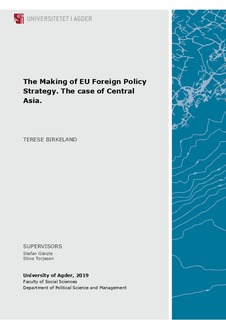| dc.contributor.author | Birkeland, Terese | |
| dc.date.accessioned | 2019-10-08T10:48:59Z | |
| dc.date.available | 2019-10-08T10:48:59Z | |
| dc.date.issued | 2019 | |
| dc.identifier.uri | http://hdl.handle.net/11250/2620861 | |
| dc.description | Master's thesis Public Policy and Management ME502 - University of Agder 2019 | nb_NO |
| dc.description.abstract | This thesis examinesthe EU foreign policy agenda-setting with regards to the drafting of the Union’snew Central Asia strategy. The EU Strategy for Central Asia was eventually released May 2019.The thesis adopts the analytical framework of Europeanization and seeks to explainthe coordination between the EU institutions on the one hand and howmember states influence EU foreign policy strategy-makingon the other.Analytically,the Europeanization framework subscribes to exploringthe EU’s impact on member states (‘down-loading’)andthe capacity of member states to shape the direction of the EU(‘up-loading’). The down-loading dimension includesthe coordination of the EU institutions, the EU delegations in Central Asia and the headquarters in Brussels(EEAS and the Commission), as the degree of centralization in these processes affect EU's abilities of influencing the member states. The up-loading dimension examines small member state literature, and by that looks at the differencesbetween small and larger member states when it comes to influencingEU’s agenda in these types of processes. Thus the research question is: Who sets the agenda for the making of EU foreign policy in the context of EU drafting its new Central Asia strategy? And how can we explain this pattern? This thesis addressesthesequestions by examiningtwo propositions: 1)The EU headquarters play the leading role in EU foreign policy strategy-making, while the EU delegations contribute with on the ground support and coordination as per instructed by the headquarters.2)Smaller member states exercise a disproportionately strong influence in the formulation of EU foreign policy strategy-making.These questions are discussed based on empirical findings from 29 semi-structed interviews which have been conductedin three Central Asian capitals(16), Brussels (12) as well as on Skype (1). This thesis shows that EU foreign policy-making has become fairly ‘normal’ with a centralized agenda-setting and where the influence by the member states comes mainly from the member states with the resources to do so. By combining the two dimensions of down-loading and up-loading in the Europeanization literature this thesis contribute to a more comprehensive way of studying EU foreign policy-making. | nb_NO |
| dc.language.iso | eng | nb_NO |
| dc.publisher | Universitetet i Agder ; University of Agder | nb_NO |
| dc.rights | Attribution-NonCommercial-NoDerivatives 4.0 Internasjonal | * |
| dc.rights.uri | http://creativecommons.org/licenses/by-nc-nd/4.0/deed.no | * |
| dc.subject | ME502 | nb_NO |
| dc.title | The Making of EU Foreign Policy Strategy : The case of Central Asia | nb_NO |
| dc.type | Master thesis | nb_NO |
| dc.subject.nsi | VDP::Samfunnsvitenskap: 200::Statsvitenskap og organisasjonsteori: 240::Internasjonal politikk: 243 | nb_NO |
| dc.source.pagenumber | 88 p. | nb_NO |

